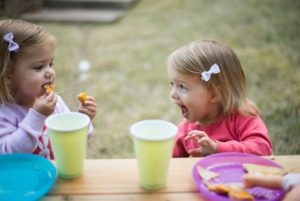Language, Language, Language


This month is going to be all about talking, listening and thinking. Its time to ‘focus in’ on the communication skills of out littlest humans!
We know that even before the pandemic we had a problem with, a language gap. I’m not going to list all the reasons why this gap exists, but taking just 2 of them, we can see how even with just these, our wee ones are challenged linguistically, even before we add the effects of the pandemic to the mix.
The first consideration for negative impact on our little ones is the over use of technology.
Although I agree that technology used well can create real and enjoyable situations for play and learning, it can also have long lasting negative impact. Many research articles suggest if little children are exposed excessively to the use of electronics they may become isolated and fail to develop normal communication skills. This exposure can also inhibit their engagement in conversation, limit their need to listen and respond and lesson the need to make eye contact with their peers. It can also impede their ability to identify social cues and be less attentive.
Language and developing our ability to share and enjoy using it, is a luscious skill to have. Literacy and Oracy skills allow our children to understand the relationship between words, to understand the nuances in meaning, to expand their vocabulary and their ability to use figurative and expressive language.
If we decide to use tech in our play, try to identify those that are made to be purposefully Playful in the children’s responses. That perhaps encourage physical skills to use or take the children on a physical journey.
Introduce a light lab that uses tech to highlight cause and effect, sensory stimulation, shadow play or lead children to have to gather loose parts to extend the engagement.
Find reasons to talk, to introduce instructions, suggestions, demonstration and modelling using chatter.
CHATTER . Lets now move on to think about our second reason for this language gap, we are considering, no one using chatter!!
Being surrounded by adults who don’t talk or have limited vocabulary themselves. When children hear a lot of words and many different words it will improve their understanding of the context they are involved in. It will also increase their vocabulary which will have a knock on effect to the variety of words that they then use and understand to their next experience. This all helps develop their language skills which in turn helps brain development.
Our play should be encouraging experimenting with sounds, making noises and babbling nonsense chatter to talking with a rich vocabulary and using a wide range of words. Each interaction will offer opportunity to listen, hear, look and pay attention.
Some interesting statistics
2019 study Professor of educational studies Jessica Logan at Ohio State University suggests that a child whose parents read them 5 books a day goes to school having heard 1.4 million more words that those who are never read to.
One book a day by the age of 5 leads to hearing 290,000 more words.
Interesting facts
Board books contain an average 140 words
Picture books contain on average 228 words
Before they are 5 a child who is never read to may have 4,662 compared to a child who is read to 1-2 times a week, they will have been exposed to around 63,570 and the child who is read to 3-5 times a week 169,520. The child who shares books daily will be exposed to 296,660 or 5 books a a day leads to the sharing of 1,483,300 words!!
When we talk about the vocabulary gap its different to the conventional word gap.
Words in books are often much more complex, more difficult. An example reading about elephants in Africa or penguins in Antarctica introduces words and concepts that don’t come up in daily conversation. These also lead to extra – textual talk about the content.
Vocab Development
Young toddlers acquire one to 3 words a month.
Most children add about 10 to 20 new words a week. After children begin understanding words in the first year their receptive vocabulary increases rapidly.
One – recognises 50
Three – recognises 1000
Five – recognises 10,000
Shipley and McAfee 2015
Have a think… how can you enrich your play to build, boost and explode each child potential for talk!

